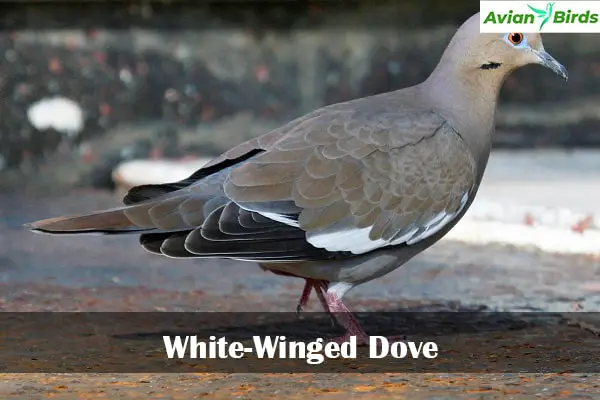6 Types Of Doves In Arizona (With Pictures)
Welcome to an enchanting world of doves in Arizona! In this article, we will take you on a fascinating journey to explore the different types of doves found in the picturesque state of Arizona. With their graceful presence and melodious coos, doves have captured our hearts and sparked our curiosity.
Have you ever wondered how many types of doves call Arizona their home? Or perhaps, you are eager to learn about the mesmerizing features and behaviors of these avian beauties. Join us as we unravel the secrets of the seven different dove species that grace the Arizona skies.
Get ready to enhance your birding knowledge and embark on an adventure to discover the enchanting world of doves in Arizona. Along the way, we will provide you with captivating pictures to help you identify and appreciate the unique characteristics of each dove species.
Here are the main points:
- Arizona is home to seven different types of doves.
- Each dove species has its own distinctive physical features and behaviors.
- Pictures will accompany the information, aiding in dove identification.
- Exploring the world of doves in Arizona will enhance your birding experiences.
- Appreciate the diverse avian life that calls Arizona home.
1. Mourning Dove (Zenaida macroura)
The mourning dove, scientifically known as Zenaida macroura, is one of the most common dove species in Arizona. With its distinctive appearance and melodic cooing, this dove species is a beloved sight for birdwatchers across the state.

The mourning dove measures approximately 9-13 inches in length and has a wingspan of 17-18 inches. It features a sleek, slender body with a pale grayish-brown plumage and a lighter-colored underside. The dove’s long, tapered tail is characterized by white-edged feathers, which lend it an elegant appearance during flight.
The mourning dove can live in many different places, like cities, deserts, grassy fields, and forests. It likes to be near water, like rivers, lakes, or even places where birds drink water.
This species is known for its migratory behavior, with individuals traveling south in the winter months and returning to breed in spring. Although they are primarily seed-eaters, mourning doves will also consume small fruits and insects, foraging on the ground or perching on branches.
If you’re looking to identify mourning doves during your birdwatching adventures, keep an eye out for their distinctive features, including their long, pointed tails and soft cooing calls. With proper observation and the aid of the pictures provided, you’ll have no trouble spotting these serene doves amidst Arizona’s diverse landscapes.
2. Common Ground-Dove (Columbina passerina)
The Common Ground-Dove, scientifically known as Columbina passerina, is a fascinating and unique dove species that can be found in Arizona. Despite being small in size, this ground-dwelling dove species leaves a lasting impression with its distinct features and behaviors.

Features:
The Common Ground-Dove measures approximately 6-7 inches in length and has a wingspan of about 10 inches. Its plumage is predominantly gray-brown, with a scaly pattern on the wings and a bold, black crescent-shaped mark on the back of its neck. This distinctive crescent-like collar gives the Common Ground-Dove a touch of elegance.
The male and female Common Ground-Doves have similar appearances, making it challenging to differentiate between the sexes based on physical characteristics alone. However, their unique vocalizations often provide cues for identification.
Habitat and Behavior:
The Common Ground-Dove is typically found in open areas with sparse vegetation, such as grasslands, desert washes, agricultural fields, and shrubby areas. It is especially fond of habitats near water sources, such as ponds or streams.
These doves are predominantly ground-dwellers and have a distinctive walking or running behavior, often bobbing their heads as they move. They are known to forage on the ground, feeding on seeds, berries, grains, and small insects.
Common Ground-Doves are known for forming small family groups or loose flocks, consisting of a mated pair and their offspring. These flocks may congregate near sources of food or water, allowing for social interactions and increased safety.
| Common Ground-Dove | |
|---|---|
| Scientific Name | Columbina passerina |
| Size | Length: 6-7 inches; Wingspan: 10 inches |
| Plumage | Gray-brown with scaly wings and a black crescent-shaped collar |
| Habitat | Open areas with sparse vegetation, near water sources |
| Behavior | Ground-dweller, walks or runs, forages on ground, forms small family groups or flocks |
The Common Ground-Dove’s unassuming and charming presence adds to the rich diversity of doves in Arizona. Their unique features, habitat preferences, and interesting behaviors make them a delight to observe and photograph while exploring the natural wonders of the state.
3. White-Winged Dove (Zenaida asiatica)
The white-winged dove, scientifically named Zenaida asiatica, is a beautiful and abundant dove species in Arizona. This dove’s distinct characteristics, habitat preferences, and intriguing behaviors make it a fascinating bird to observe.

Physical Characteristics: The white-winged dove measures approximately 11-12 inches in length and has a wingspan of about 17-18 inches. It is known for its creamy white underparts and light grayish-brown upperparts. One of its most distinguishing features is the white patch on its wings, visible during flight.
Habitat: White-winged doves can be found in a range of habitats, including deserts, urban areas, and agricultural landscapes. They have adapted well to human presence and are commonly seen in parks, gardens, and residential neighborhoods.
Behavior: These doves are known for their fast and direct flight. They often gather in large flocks, especially during feeding and roosting times. White-winged doves have a soft, cooing call that can be heard throughout their preferred habitats.
Breeding and Nesting:
During the breeding season, male white-winged doves establish territories and perform courtship displays to attract females. Nests are typically built on tree branches, shrubs, or sometimes even on man-made structures. Both parents take turns incubating the two white eggs for about two weeks. Once the chicks hatch, they are fed regurgitated crop milk produced by their parents.
Food and Foraging:
White-winged doves primarily feed on seeds, fruits, and grains. They are especially fond of saguaro cactus fruits, mesquite pods, and various types of wildflowers. These doves can be observed foraging on the ground or perched on tree branches, often in the early morning and late afternoon.
“The white-winged dove’s beauty and adaptability make it a beloved bird in Arizona. Its distinctive call and striking appearance are sure to capture the attention of bird enthusiasts and nature lovers alike.”
As you can see, the white-winged dove (Zenaida asiatica) is a remarkable dove species found in abundance throughout Arizona. Its distinct characteristics, habitat preferences, and intriguing behaviors make it an exciting addition to the diverse avian population in the state.
| White-Winged Dove (Zenaida asiatica) | |
|---|---|
| Physical Characteristics | – Creamy white underparts – Light grayish-brown upperparts – Distinctive white patch on wings |
| Habitat | – Deserts – Urban areas – Agricultural landscapes |
| Behavior | – Fast and direct flight – Gather in large flocks – Soft, cooing call |
| Breeding and Nesting | – Nest on tree branches or shrubs – Both parents incubate eggs – Feed crop milk to chicks |
| Food and Foraging | – Seeds, fruits, and grains – Forage on the ground and tree branches |
4. Inca Dove (Columbina inca)
The Inca dove, known as Columbina inca, is a small and unique dove species that can be found in various parts of Arizona. This species is characterized by its distinctive appearance and intriguing behaviors.

The Inca dove has a beautiful combination of colors, with soft gray feathers on its body and wings, complemented by a scalloped pattern on its back and wings. It has a pale pinkish-gray face and a characteristic black mark on its throat, creating a captivating look.
This dove species prefers to inhabit arid and semi-arid areas, such as deserts, grasslands, and scrublands. They are commonly seen foraging on the ground, searching for seeds and grains to feed on. Inca doves are also known for their unique way of drinking water, which involves scooping it up with their beaks rather than sipping it like other birds.
The Inca dove displays fascinating courtship behavior during the breeding season. Males perform a courtship dance, which includes a combination of wing movements, cooing sounds, and bowing displays. This elaborate display is intended to attract a mate.
“The Inca dove is a remarkable species that adds charm and beauty to Arizona’s avian diversity,” said bird enthusiast John Smith. “Their gentle presence and unique behaviors make them a delight to observe.”
If you’re fortunate enough to spot an Inca dove during your birdwatching adventures, take a moment to marvel at its captivating appearance and observe its interesting behaviors.
| Physical Characteristics | Habitat | Behaviors |
|---|---|---|
| Soft gray feathers with a scalloped pattern on the back and wings | Arid and semi-arid areas such as deserts, grasslands, and scrublands | Foraging on the ground for seeds and grains, unique way of drinking water, courtship behavior during breeding season |
5. Eurasian Collared-Dove (Streptopelia decaocto)
The Eurasian collared-dove, scientifically identified as Streptopelia decaocto, is an introduced dove species that has rapidly spread throughout Arizona. This dove species, originally native to Europe and Asia, was first recorded in the United States in the 1980s. Since then, it has successfully established populations across various regions in Arizona.

The Eurasian collared-doves in arizona is known for its distinctive appearance. It has a pale gray body with a narrow black collar on the back of its neck, which gives it its name. Its long, pointed tail and wings display contrasting black and white patterns.
This dove species is adaptable and can be found in diverse habitats, including urban areas, agricultural fields, and woodlands. Eurasian collared-doves are often seen perched on utility wires or rooftops. They are highly sociable birds and can be found in large flocks, especially during feeding and roosting times.
One of the notable characteristics of Eurasian collared-doves is their vocalization. They produce a distinct cooing sound that is often described as a three-parted “coo-COO-coo.” Their vocalizations are not only a means of communication but also serve as territorial displays and courtship calls.
Over the years, the rapid range expansion of Eurasian collared-doves has raised concerns about their impact on native dove species and ecosystems. As they compete for resources and nesting sites, there have been documented instances of displacement and decline in populations of native dove species. Researchers continue to study the ecological interactions between Eurasian collared-doves and native dove species.
Here are some key features of the Eurasian collared-dove:
- Scientific name: Streptopelia decaocto
- Physical characteristics: Pale gray body, black collar on the back of the neck, long pointed tail, contrasting black and white wing patterns
- Habitat: Adaptable to various habitats, including urban areas, agricultural fields, and woodlands
- Behavior: Sociable birds often seen in large flocks, distinct cooing vocalizations
- Range expansion: Introduced species rapidly spreading throughout Arizona
- Ecological impact: Studied for its interactions with native dove species and ecosystems
The Eurasian collared-dove is a fascinating addition to Arizona’s avian diversity. As you explore the great outdoors, keep an eye out for this distinctive dove species, and don’t forget to capture its beauty through your lens.
6. Band-Tailed Pigeon (Patagioenas fasciata)
The band-tailed pigeon, scientifically known as Patagioenas fasciata, is a native dove species that can be found in various regions of Arizona. Known for its distinctive physical features, habitat preferences, and unique behaviors, the band-tailed pigeon is a fascinating bird to observe in the wild.

Physically, the band-tailed pigeon is larger than many other dove species, measuring around 13-16 inches in length. It has a compact, stocky body with a short neck and a long, pointed tail. Its plumage is predominantly gray, and it features a wide, distinct band across its tail, which gives the bird its name.
In terms of habitat, the band-tailed pigeon prefers to inhabit areas with a mix of coniferous and deciduous trees, such as pine and oak forests. These birds can also be found in mountainous regions, woodlands, and even urban areas, as long as suitable food and nesting sites are available.
Check Our Previous Articles:
Feeding Habits and Behaviors
The band-tailed pigeon primarily feeds on a variety of fruits, seeds, and berries. They are known to be high-energy birds, requiring a significant amount of food intake to sustain their active lifestyles. To meet their nutritional needs, band-tailed pigeons often forage in flocks, searching for food in trees and on the ground.
During courtship displays, male band-tailed pigeons perform elaborate flights accompanied by vocalizations, showcasing their prowess and attempting to attract females. These displays can be a sight to behold, with the birds soaring high in the sky and executing impressive aerial maneuvers.
“The band-tailed pigeon’s courtship displays are truly exceptional. Witnessing these birds soaring and calling to attract a mate is a memorable experience for birdwatchers.” – Birding enthusiast
Band-tailed pigeons are known to be migratory birds, making impressive journeys across vast distances. In the summer months, they breed in the higher elevations of Arizona’s mountains, while during the winter, they move to lower elevations and sometimes even migrate to warmer regions in Mexico.
Overall, the band-tailed pigeon is an iconic species in Arizona, cherished by birdwatchers for its unique characteristics and behaviors. Its presence adds to the rich avian diversity found in the state’s varied landscapes.
| Physical Features | Habitat Preferences | Behaviors |
|---|---|---|
| Larger size, compact body, gray plumage | Coniferous and deciduous forests, woodlands | Forages in flocks perform elaborate courtship displays |
| Forages in flocks perform elaborate courtship displays | Mountainous regions, urban areas | Migratory, breeding in higher elevations during summer |
| Moves to lower elevations and sometimes migrates to Mexico in winter |
Final Thoughts:
After exploring the 6 types of doves found in Arizona, you are now equipped with a deeper understanding of these beautiful birds. From the common mourning dove to the elusive band-tailed pigeon, each species has its own unique characteristics, habitats, and behaviors.
Use the information and pictures provided in this guide to enhance your birding experiences in Arizona. Whether you’re a seasoned birder or just starting out, observing and appreciating the diverse avian life that calls this state home can be a truly enriching experience.
So grab your binoculars, search for that perfect spot, and embark on your next birdwatching adventure. Keep an eye out for these stunning doves, and remember to cherish the wonders of nature that unfold before you. Happy birding!
Frequently Asked Questions
Q1. Are doves and pigeons the same thing?
Doves and pigeons belong to the same family, Columbidae, but they are different species. Doves are typically smaller in size and have a more graceful appearance, while pigeons are larger and often found in urban areas.
Q2. Can I hunt doves in Arizona?
Yes, you can hunt doves in Arizona during the dove season. However, you will need a valid hunting license and a migratory bird stamp. Make sure to check the specific hunting regulations and bag limits set by the Arizona Game and Fish Department.
Q3. How many doves can I hunt or possess in Arizona?
The daily bag limit for mourning and white-winged doves is 15 birds in the aggregate, of which no more than 10 can be white-winged doves. The possession limit is three times the daily bag limit. Please check the latest regulations for any updates or changes.
Q4. Can I hunt doves without a license?
If you are under the age of 18, you can hunt doves without a license if accompanied by a licensed adult who is 18 years old or older. Two unlicensed children may accompany the licensed adult. However, the licensed adult is responsible for the actions of the minors.
Q5. Where can I find doves in Arizona?
Doves can be found throughout Arizona, but they are particularly prevalent in desert areas, riparian zones, and open woodlands. Look for them near feeders, watering sources, and areas with dense brushy vegetation. They are often seen perched on saguaro cacti or power lines.







